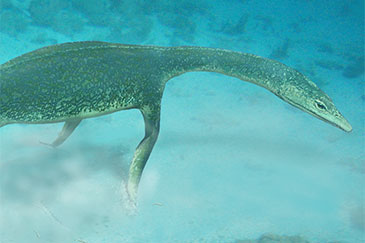
Ancient marine reptiles propelled themselves through the water, across the seafloor millions of years ago. Scientists have discovered a trackway formed on a prehistoric seabed that sheds light on how nothosaurs, the prehistoric marine creature travelled across the sea.
Nothosaurs, lived during the dinosaur's age when the seas were ruled by marine reptiles, around 252 to 66 million years ago. This group of reptile was huge semi-aquatic hunters with long stretched bodies with paddle-like limbs. During the period of Triassic, these aquatic reptiles were the top predators. Yet, until now, scientists had not been able to answer how these reptiles moved through the water.
Scientists from the University of Bristol and colleagues in China then studied the trackways formed on the southwest China's seabed. The pathway was recently uncovered in Yunnan, southwest China, where they found that the tracks comprised of slots in the mud that were arranged in pairs and in long series of ten to 50 in straight or curved lines.
"We interpret the tracks as foraging trails. The nothosaur was a predator, and this was a smart way to feed. As its paddles scooped out the soft mud, they probably disturbed fishes and shrimps, which it snapped up with needle-sharp teeth." said Qiyue Zhang, one of the researchers, in a news release.
Nothosaurus mode of swimming has long been be wondered by scientists. Some thought that these reptiles rowed themselves back-and-forth using their limbs as paddles, while some thought they flew under the water, like a modern penguin.
The scientists believe that the trackway comprised of paddle prints of large Nothosaurus and the small Lariosaurus.
"When I first saw the site, I couldn't believe the amazing quality of the fossils. It's quite unusual to find skeletons of marine reptiles such as the nothosaurs so close to evidence of their tracks." said Michael Benton, one of the co-authors of the research University of Bristol.
Scientists were also able to reveal about how these creatures lived millions of years ago, which in turn also sheds some light on the conditions during those periods.
The tracks were discovered from localities around Luoping in Yunnan – a site well known for exceptional fossil preservation. Scientists have yielded several fossils of sea creatures from this site, along with some occasional plants and small terrestrial animals that happened to have swayed from nearby islands.
"Here we see a detailed snapshot of how life was within 8 million years of the mass extinction. It took all that time for Earth to settle down from the cataclysm and the arrival of these large, complex marine predators shows us the ecosystems had finally rebuilt themselves, and life could be said to have recovered from the crisis," said Shixue Hu, one of the researchers.













